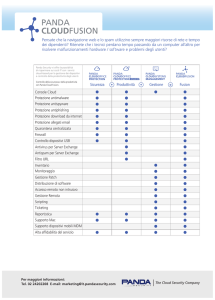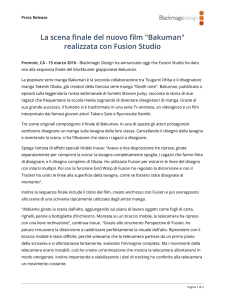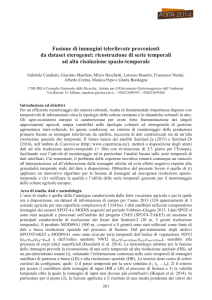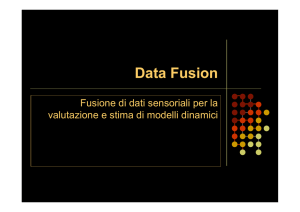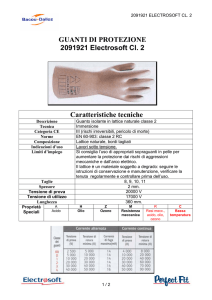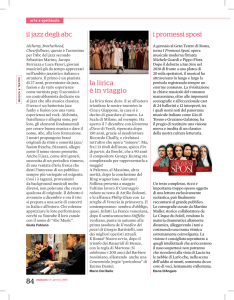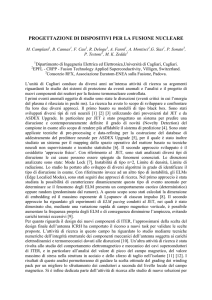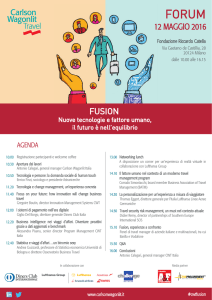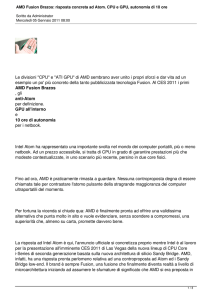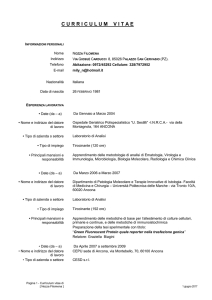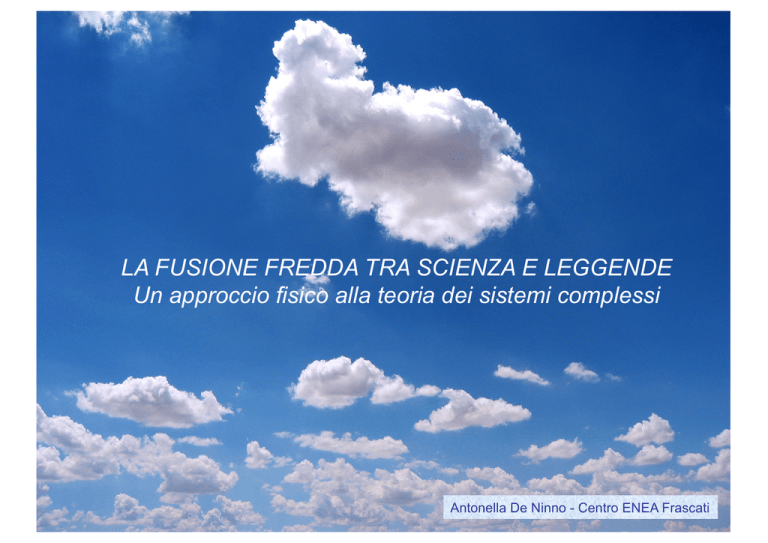
Antonella De Ninno – C.R. ENEA Frascati
LA FUSIONE FREDDA TRA SCIENZA E LEGGENDE
Un approccio fisico alla teoria dei sistemi complessi
Antonella De Ninno -­ Centro ENEA Frascati
Now, what I want is, facts. Teach these boys and girls nothing but Facts. Facts alone are wanted in life. Plant nothing else, and root out everything else. You can only form the minds of reasoning animals upon Facts: nothing else will ever be of any service to them. This is the principle on which I bring up my own children, and this is the principle on which I bring up these children. Stick to Facts, sir!
Charles Dickens
I Principi dell’empirismo
1.
2.
Ogni corpo in natura è in principio isolabile purché lo si allontani sufficientemente dagli altri corpi
Il corpo isolato si muove di moto rettilineo uniforme a meno che non sia soggetto a forze esterne
• Questa visione atomistica della materia è perciò legata ad una concezione della materia come essenzialmente passiva, incapace di auto-­movimento e di auto-­
organizzazione. Il suo movimento dipende sempre dall’intervento di agenti esterni.
• In questo quadro concettuale l’esigenza di una visione sistemica del reale deve fondarsi necessariamente sull’intervento di cause esterne.
• Non è un caso perciò che la teoria dei sistemi diventi spesso appannaggio degli ingegneri, la cui professione è appunto quella di organizzare, come in un meccano, gli elementi sparpagliati e in principio disgiunti della realtà All’inizio del 900 vennero a maturazione, contemporaneamente, due rivoluzioni:
1. La rivoluzione atomistica (prova finale dell’esistenza degli atomi sulla base dei lavori sull’interpretazione dei moti Browniani di Einstein e dei lavori di spettroscopia atomica)
2. La rivoluzione quantistica, nata nel 1900 con il celebre lavoro di Max Plank sulla radiazione di corpo nero
Nell’ambito della cultura corrente è usuale considerare queste due rivoluzioni come un'unica rivoluzione e considerare quindi la teoria quantistica equivalente alla teoria degli atomi. Gli sviluppi della fisica teorica della seconda metà del 900 mettono però in dubbio questa concezione e vedono anzi nella rivoluzione quantistica lo strumento concettuale per portare al tramonto la visione della materia come mera aggregazione di atomi. Esamineremo nel seguito in dettaglio questo punto di vista.
Nella fisica classica (quella di Galilei, Cartesio e Newton) il vuoto, lo spazio-­tempo privo di qualsiasi traccia di materia é una nozione puramente negativa.
Con l’avvento della meccanica quantistica, la visione del mondo cambia
(Invarianza di gauge)
Il campo quantistico
1. Un campo quantistico non é altro che l’insieme (infinito) dei suoi moti ondulatori (le onde piane del campo elettromagnetico, ad esempio) 2. E’ definito attraverso la quantizzazione dei suoi moti che sono formalmente riconducibili ad oscillatori, il cui impulso e la deviazione dal punto di equilibrio non possono essere contemporaneamente nulli, come afferma il principio di Heisemberg.
3. Se non fosse così, il vuoto tornerebbe ad essere quello immaginato dalla fisica classica. La vera differenza la fa il moto di punto zero che priva il vuoto, lo stato quantistico di minima energia, della sua non-­entità classica
Horror vacui
Horror quietis
Lo spazio e il tempo non precedono la materia ma ne sono un prodotto (Einstein – relatività generale)
Il vuoto quantistico precede la materia ed è privo di struttura spazio-­temporale
Gli oggetti interagenti tra loro attraverso il vuoto quantistico non sono perciò connettibili soltanto in modo causale
L’ interpretazione di David Bohm, negli ultimi anni ha guadagnato consensi e ha portato alla scoperta dei cosiddetti fenomeni quantistici macroscopici i quali mostrano che la descrizione quantistica non è confinata al mondo atomico e subatomico, ma coinvolge anche il mondo macroscopico consentendo per la prima volta di intravvedere la soluzione del problema del movimento spontaneo della materia. I corpi possono essere correlati mediante la loro interazione attraverso il vuoto diventando così, usando il gergo della fisica contemporanea, entangled .
Per sistemi assai diluiti di cariche (come ad esempio nei plasmi o nella fisica delle alte energie) per N » 1023 cm -3
V
la definizione di “vuoto perturbativo” o vuoto classico é una ottima approssimazione.
Nel 1972, due noti ed autorevoli fisici K.Hepp e E. Lieb dimostrarono che in un sistema di N atomi a due livelli, accoppiati in modo risonante ad un singolo modo di un campo elettromagnetico (il modello base della fisica del laser), esiste una transizione di fase detta superradiante se:
T < Tcritica ; r > rcritica
Si tratta di uno stato coerente di materia e campo, del tipo di quello che si instaura nei laser, con la differenza che ciò avviene
spontaneamente
lo stato a cui si perviene è un insieme di atomi oscillanti tra due configurazioni in accordo di fase tra di loro, come i componenti di un corpo di ballo;; gli atomi non sono più indipendenti ma sono coerenti e danzano al ritmo di un campo elettromagnetico inseparabile da loro , permanentemente intrappolato all’interno di una regione denominata , per ovvi motivi, dominio di coerenza ( DC) , la cui dimensione è data dalla lunghezza d’onda del campo elettromagnetico risonante con la transizione tra le due configurazioni.
Emilio Del Giudice
Giuliano Preparata
Questi stati “coerenti” di campo em e materia realizzano I minimi di energia che conferiscono alla materia condensata (liquida e solida) l’enorme stabilità e varietà che ci sono così familiari.
In tal modo, trovano razionalità, un gran numero di fenomeni, dalla superconduttività alla superfluidità, al ferromagnetismo, alla fusione fredda alla biologia quantistica.
What is Cold Fusion ?
it is a nuclear reaction between two deuterium nuclei with the following characteristics:
• it takes place in a dense medium and not in vacuum (plasmas can be considered as "vacuum" if compared with a number of atoms as high as the Avogadro's number typical of the condensed matter) • it doesn't need a critical parameter such as the product of the density by the temperature, thus it can happen at room temperature at the ordinary density of the matter, even if not in the ordinary state of matter. Cold Fusion: two huge anomalies !
•
•
The deuterons loaded into a Pd cathode in an electrolytic experiment can be accommodated in the octahedral sites of its lattice. The nuclear fusion rate expected to justify the heat measured in cold fusion experiments is hundreds of magnitude higher than one expects in the D2 molecule, where deuterons are located even closer.
Deuterons fuse following a path completely different from that in vacuum where the two reactions: D+D → p(3.02 MeV) + 3H (1.01MeV)
D+D → n(2.45 MeV) + 3He (0.82 MeV)
have each the branching ratio close to 50%
The phenomenology of LENR
Nuclear phenomena induced in metal host lattice have been observed using three principal methods of approach:
• Electrochemical loading
• Ion implantation
• Gas-­phase loading and/or gas flux
Scientific question
Early history
Ion implantation
Gas phase loading
Electrochemical loading
Non-­equilibrium conditions
Non-­equilibrium conditions
Fleishmann observed that the transient compression induced by such non equilibrium conditions (temperature changes, gas flux, compression waves) is broadly equivalent to the steady state compression induced by cathodic polarization
Early history
The objections raised by part of the scientific community against the experimental evidence of excess heat production in heavy water electrolysis on Pd cathode, are mainly based on the opinion that such a phenomenon is unconceivable on the basis of the common accepted condensed matter physics.
The decision of Martin Fleischman to get on Cold Fusion researches in 1983 was based on the belief that Quantum Mechanics alone was not able to explain some experimental facts, which require some new approach.
The Fleischmann intuition implied that nuclear transformations of D+ compressed into Pd lattice would differ substantially from the reactions observed in dilute plasmas.
The existence of a collective dynamics in condensed matter able to produce relevant energy outcomes not accountable in terms of localised events is supported by a number of phenomena. A topic relevant to this research has been the work carried out by Percy William Bridgman (Nobel laureate in 1946) in the 1930’s.
He found that the energy stored in a lattice, when intense shear and compression are applied, gets released in “cold explosions”.
(P.W. Bridgman, The physics of high pressure, International Textbooks of Exact Science, London 1947).
A second phenomenon has emerged from the work of Alfred Cöhn in 1929 on the electrodiffusion of hydrogen in the Pd lattice. Hydrogen was found to be present in the lattice (at that time deuterium has not yet been discovered) in form of protons. Other surprising features are the very high diffusion coefficients ( of the order 10-­7 cm2s-­1 for hydrogen in the a phase) and the fact that the diffusion coefficient are in the order DD+>DH+>DT+ different from which can be expected on the basis of a simple classical model of diffusion.
Another observation which had an importance on the decision to initiate a work on “cold fusion” was the measurement of very high equilibrium H/D separation factor
for hydrogen and deuteruim dissolution into palladium cathodes at high negative overpotentials.
The interpretation of this fact requires the assumption that the species behave as classical oscillators in the lattice, i.e. they are virtually unbound.
(B. Dandapani, M. Fleischmann, J. of Electroanal. Chem. 39 (1972)323)
Pd hydride (or deuteride) is a quite peculiar system and it looks like a “solid plasma”.
Oscillations in condensed matter
(thermal motion)
Oscillation in condensed matter
(with an e.m. field)
E (w)
Coherent oscillations in condensed matter
E (w)
Coherence Domain
Thus deuterons inside Pd lattice can be envisaged as a plasma in condensed matter having a strong electromagnetic coupling with the lattice.
The (1,1,0) plan of the Pd lattice
Pd site
octahedral site
tetrahedral site
h
x
Possible plasma oscillations of d-­electrons shells
h
d-­electrons shell
x
disk of “static” charge
The profile of the electrostatic potential in the h-­direction
eV
eV
a0= 0.7Å
h
the plasma of d-­electrons generates a screened
elecrostatic potential at tetrahedral sites
Can Cold Fusion be real ?
The question about the reality of CF is usually asked in the context of Quantum Mechanics which shows that “Cold Fusion” should not be possible:
the nuclear physics of deuterons in the lattice (with a space-­time scale some six orders of magnitude smaller than the space-­time scales of the lattice) should not differ from the nuclear physics in the vacuum (that is the principle of Asymptotic Freedom).
However AF is not a general property of the coherent ground state of QED in condensed matter !
Suppose that a fusion be a physical event localized at a definite site of the lattice:
The compound nucleus D+D must release its exceeding energy (in order to relax to a stationary state) in the time allowed by the Heisenberg uncertainty principle DEDt ~ ħ. In order to reach the nearest atom at a distance of about 3 Å (i.e. about the distance between first neighbour in Pd lattice) the velocity of the energy transfer should be orders of magnitudes larger than the light speed, then the only possibility for the nucleus is to fission in fragments as expected in vacuum!
According to the universally accepted principle of physics it is impossible to dissipate energies of MeV simply “heating” the lattice without emission of very energetic fragments that have not been observed in these phenomena. Cold fusion cannot be a localized event but implies the revision of some of our implicitly assumed facts about condensed matter.
dd fusion in vacuum
3H
2H
+
1
n
+ 2H1
+
4He
1 n +
2
n
+
3He
0.1
0.2
0.3
n
+
n +
+ n
+ n
0
+ 1H1
0.4
0.5
0.6
Time (´10-­21 s)
0.7
2 0.8
n
+ 1n0
0.9
1.0
dd fusion in condensed matter
• In condensed matter the boiling He nucleus can release its energy to the e.m. field
• If such a process is quick enough, it is not forced to break into fragments
n +
+ n
• We can thus observe 4He atoms and heat
0
0.1
0.2
0.3
0.4
0.5
0.6
Tempo (´10-­21 s)
0.7
0.8
0.9
1.0
Thermostatic Box
n.o.
Gas mixture
Storage
circuit
n.o.
inert gases
Sample
volume
n.c.
NEG
pump
n.c.
Peltier element
QMA
UHV
chamber
Cell
UHV
containment
vessel
Cathode resistance
Power in (cell voltage and current)
Power out (trought Peltier voltage)
Voltage across the cathode
Temperatures
Electrolyte
Loading
(a) LiOD
X > 1
(b) LiOD
X < 1
(c) LiOH
X > 1
Average 4He Total amount of 4He atoms yield
produced 4He produced/initial
(atoms/sec)
6.1 ± 0.8 x 1010
8.1 ± 0.2 x 1014
25.5 ± 0.8
-­2 ± 3 x 108
-­2 ± 3 x 1011
-­0.2 ± 0.1
1.37 ± 0.04 x 1014
1.82 ± .03
4 ± 3 x 109
The historical branch between beam fusion and magnetic confinement fusion
The very first nuclear fusion reaction used the 100-­kV powerful gas discharge developed by Mark Oliphant, the heavy water for the deuterium was produced by Paul Harteck, and the analysis of the cloud chamber was done by Lord Rutherford.
First attempts to develop the reaction into an energy source were done by Oliphant in 1937
The development went first against the initial concept of beam fusion in favor of avoiding any beams and going only into the direction of magnetic confinement fusion.
M.C. Oliphant, P. Harteck and Lord Rutherford, Nature 113 (1934) 413 Spitzer criterion about the
impossibility of beam fusion
The first efforts done by the Nobel laureate Lawrence and Oliphant was to produce extremely intense deuterium or D-­T beams from gas discharges or otherwise, with about 100 keV of energy, to irradiate targets containing D or D-­T.
These attempts were radically rejected by Spitzer (1957) who argued that such beam experiments do well result in fusion reactions as measured but it is absolutely impossible to produce more energy by fusion than is put in for the beams.
The Spitzer objection was that the ion energy goes mostly into heating of the electrons in the target, never permitting an exothermal fusion reaction.
Thermonuclear fusion
Spitzer option led to the decision that instead of bombarding a cold target, one has to heat the reacting particles all, as in the sun, up to the plasma state of a temperature of dozens of millions of degrees such that ions do not lose their energy by collisions with electrons and the desired fusion reactions can take place.
Following Spitzer’s argument, the handling of the fusion
plasma with magnetic confinement is at a stage that a test
reactor ITER is going to be built by 2015, which may lead to
a power station for 4 GW fusion energy output by 2040
The ITER Project: International Collaboration to Demonstrate Nuclear Fusion
Generatore di neutroni compatto
A deuterium-­tritium base reaction pulsed neutron generator packaged in a flat computer chip shape of 1.54 cm (0.600 in) wide by 3.175 cm (1.25 in) long and 0.3 cm (0.120 in) thick has been successfully demonstrated to produce 103 neutrons per pulse (14 MeV) in a 0.5-­ μs pulse. The neutron generator is based on a deuterium ion beam accelerated to impact a tritium-­loaded target. The accelerating voltage is in the 15-­ to 20-­kV range with a 3-­mm (0.120 in) gap
The neutron was discovered as the product of an early radiochemical fusion reaction in 1932. Following a decade of mainly scientific use, the WWII nuclear bombs exploded over Japan each included a neutron generator to ignite the critical mass of fissionable material at the correct time. This event neatly split development of neutron generators between the secret and the open worlds.
Source: Sandia National Laboratories
STATIONARY TARGET FUSION
MAGNETIC CONFINEMENT FUSION
Fusion product= density X Energy confinement Time X Temperature
d » 10 particles / m
23
t ® ¥
3
d » 1015/20 particles / m3
t » 1sec(Tokamak )
Is it possible to realize a solid-­state plasmas ?
Spitzer’s argument keeps its full validity as long as the beam-­
irradiated target remains solid.
The basic concept of thermonuclear fusion is to produce extremely high energy densities within very short times in very small volumes. Actually, we know that solid-­state plasmas can be naturally available in nature !
It is legitimate to wonder whether the experiments using deuterium flux or implantation in an appropriate cathode which fulfills the “plasma” condition (i.e. over the loading threshold) are an unusual
verification of the Oliphant beam fusion.
The Sandia National Laboratories disclosure does not mention how the deuterium gas is stored, but one common approach is to coat the ion source and/or the target with palladium or some other metal that readily forms hydrides, or in this case, deuterides. For example, a palladium coating can store nearly one deuterium atom for each palladium atom. The ion current is sufficiently low that even these small amounts of deuterium will last a very long time in the completed neutristor.
"As I write this Foreword, California is experiencing rolling blackouts due to power shortages. Conventional engineering, planned ahead, could have prevented these blackouts, but it has been politically expedient to ignore the inevitable. We do not know if Cold Fusion will be the answer to future energy needs, but we do know the existence of Cold Fusion phenomenon through repeated observations by scientists throughout the world. It is time that this phenomenon be investigated so that we can reap whatever benefits accrue from additional scientific understanding. It is time for government funding organizations to invest in this research.”
Dr. Frank E. Gordon, Head
Navigation and Applied Sciences Department
Space and Naval Warfare Systems Center, San Diego" What we know about LENR
a) the existence of a threshold of deuterium loading in Palladium is generally assumed as necessary (even if some time not sufficient) to trigger the phenomenon;;
b) the mismatch between the measured yield of neutrons and tritium and the theory of nuclear fusion in vacuum;;
c) the presence of 4He as nuclear ash of the process in the electrolytic loading of Pd over the threshold;;
d) the existence of other nuclear reactions, as transmutations of heavy elements, in condensed matter at room temperature;; e) the necessity of collective behavior in condensed matter in order to cope with this new phenomenology.
Le reazioni biochimiche
ESISTENZA DI CODICI NELL’INSIEME DELLE REAZIONI BIOCHIMICHE
Alte temperature di esercizio
Grande quantità di scarti
Utilizzo di catalizzatori
CHIMICA INDUSTRIALE
Le parti del processo chimico industriale
Reinterpretate alla luce della QED
• L’energetica e la cinetica delle reazioni chimiche di ioni in soluzione connesse con la separazione del solvente (l’acqua) in regioni coerenti e non coerenti
• L’influenza di campi magnetici statici deboli ed alternati debolissimi sulla conducibilità di specie ioniche in soluzione. Questo aspetto presenta importantissime implicazioni di tipo biologico perché permette di reinterpretare i meccanismi di trasmissione ionica attraverso le membrane cellulari.
• La comprensione delle strane proprietà magnetiche dell’acqua
• La possibilità di sviluppare sorgenti di energia a basso impatto ambientale.
NEGHENTROPIA
Erwin Schroedinger 1887 – 1961
(What is Life ? -­1944)
Premio Nobel per la Fisica nel 1933
INFORMAZIONE BIOLOGICA ↔ DIMINUZIONE DELL’ENTROPIA
Ilya Prigogine 1917 -­2003
Premio Nobel per la Chimica nel 1977
diminuzione dell’entropia ↔ autoorganizzazione del sistema vivente
e ~ 1
T1 - T2
h =
T1
65-­70%
99%
L’interazione tra I corpi avviene Igor Evgeny Dzyaloshinskii, attraverso le fluttuazioni del Lev Pitaevskii
campo elettromagnetico
Evgeny Lifshitz
Le interazioni nella materia Herbert Fröhlich 1905-­1991
vivente sono mediate dai campi elettromagnetici
Emerge una dinamica auto-­organizzatrice che trasforma una pluralità di atomi indipendenti in una unità di atomi cooperanti, cosa che corrisponde ad un Giuliano Preparata 1942-­2000
drastico calo di Emilio Del Giudice
entropia
acqua
L’attività biologica delle proteine è legata alla formazione di un insieme strutturato di molecole di acqua.
Questo network è in grado di trasmettere informazioni nell’intorno delle proteine e di influenzarne la dinamica
Three separate part of the ribonuclease molecule are hold together by the centrally-­‐placed water molecule
grazie per l’attenzione

